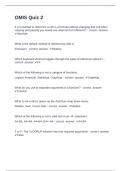NUR2063 \ NUR 2063 EXAM 2 |
PATHOPHYSIOLOGY PRACTICE
QUESTIONS AND ANSWERS RATED
A+ | RASMUSSEN
What are the signs and symptoms of acute kidney injury?
- Correct Answer - Sudden reduction in kidney function,
decreased urine output, although occasionally urine output
remains normal
Fluid retention, causing swelling in your legs, ankles or feet
Shortness of breath
Fatigue
Confusion
Nausea
Weakness
Irregular heartbeat
Chest pain or pressure
Seizures or coma in severe cases
,What are the 3 stages of causes of acute kidney injury
- Correct Answer - pre renal, intrarenal or intrinsic, post renal
What are the pre renal causes of AKI?
- Correct Answer - disruption in renal perfusion and blood flow.
It can cause low blood pressure, low blood volume, heart
failure, renal artery obstruction, fever, vomiting, diarrhea, burns
that lead to dehydration, Drugs such as ACE inhibitors or
angiotensin 2 blockers, NSAIDs that can drop the blood
pressure or cause bleeding
What are the intrarenal/intrinsic causes of AKI?
- Correct Answer - damage or disruptions within the kidney
blood vessels, tubules, or glomeruli. It can cause reduced blood
supply within the kidneys, toxic injury with medications, chemo,
and contrast medias, renal inflammation, or prolonged prostate/
stones/ in the post renal stage
What are the post renal causes of AKI?
- Correct Answer - caused by an obstruction in the urinary
collecting system, urethra, bladder, or ureters due to stone,
tumor, or enlarged prostate that results in elevated pressure in
,the Bowman's capsule that impedes glomerular filtration.
Prolonged injury can lead to intrinsic injury and irreversible
damage
What are the 3 stages of AKI presentation?
- Correct Answer - prodromal, oliguric, postoliguric
Explain what happens during prodromal presentation of AKI
- Correct Answer - normal or declining urine output, The BUN
and creatinine levels rise, showing there is a problem. Duration
of this phase depends on cause of injury, amount of toxin,
duration of hypotension
Explain what happens during oliguric presentation of AKI
- Correct Answer - lasts up to 8 weeks with usual urine output
being 50ml-400 mls, when normal output is 30 ml per hour.
Characterized by oliguria, lower GFR, and hypovolemia. S/S of
fluid excess, hyperkalemia, uremic syndrome. Dialysis may be
needed.
Explain what happens during postoliguric presentation of AKI
, - Correct Answer - Urine volume increases, leaving patient at
risk for dehydration and electrolyte imbalances they are ridding
themselves of too much fluids. Higher GFR, and can last 1
week-1 year. Full recovery when BUN and creatinine levels are
normal, but renal insufficiency may occur. (early recovery of the
condition, but not all recover)
What happens if AKI does not resolve?
- Correct Answer - chronic kidney disease
What are the causes of chronic kidney disease?
- Correct Answer - outcome of progressive and irrevocable loss
of the nephrons, associated with hypertension, diabetes,
recurrent pyelonephritis, glomerulonephritis, polycystic kidney
disease, history, toxins, age. Leading from AKI
What are the complications one may have from chronic kidney
disease?
- Correct Answer - cardiovascular disease, hypertension,
uremic syndrome, metabolic acidosis, electrolyte imbalance,
malnutrition, anemia, pain, depression





